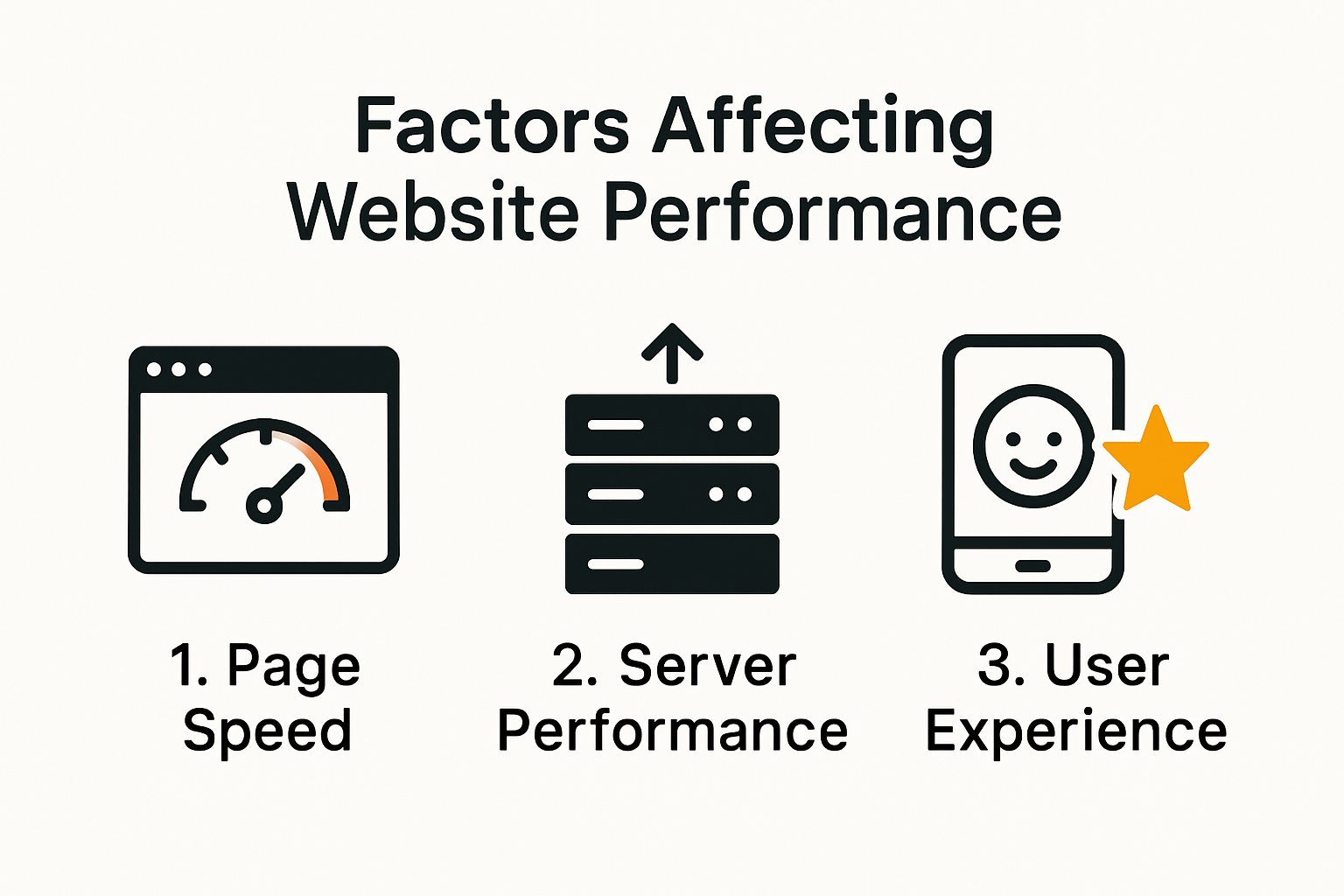Website Performance Optimization: Actionable Tips for 2025


Website performance is make or break for online success and even a one second delay in page load causes conversion rates to drop by up to 7 percent. Most people think loading speed is just about shrinking images or swapping out web hosting companies but that only scratches the surface. The most effective improvements come from a mix of technical tweaks, smarter design choices, and strategic metrics tracking that almost nobody talks about.
Table of Contents
- Key Factors Affecting Website Performance
- Proven Techniques To Boost Site Speed
- Optimizing Images, Scripts, And Hosting
- Tracking And Measuring Website Performance
Quick Summary
| Takeaway | Explanation |
|---|---|
| Optimize Technical Performance | Focus on server response time, efficient coding, and minimizing HTTP requests to enhance overall website effectiveness. |
| Leverage CDNs for Speed | Utilize Content Delivery Networks to distribute content and reduce latency, thus improving loading times and user retention. |
| Implement Image Optimization | Use strategies like compressing images and modern formats to significantly enhance page load speed and user experience. |
| Track Essential Performance Metrics | Regularly monitor KPIs like page load time and bounce rate using analytics tools to identify improvement areas and enhance user engagement. |
| Ensure Accessibility Compliance | Regular audits for Section 508 compliance are essential for making websites inclusive, improving usability for all users. |
Key Factors Affecting Website Performance

Website performance isn't just about speed. It's a complex ecosystem of technical and user experience elements that determine how effectively a website engages and retains visitors. Understanding these critical factors can transform an average website into a high-performing digital platform.
Technical Performance Foundations
Technical performance serves as the backbone of website effectiveness. Research from the International Journal of Technology and Human Interaction reveals that multiple interconnected metrics significantly impact overall website performance. These include unique pageviews, average time on page, site entrances, and exit percentages.
Server response time plays a crucial role in determining user experience. Websites that load within two seconds retain user attention, while those taking longer risk increased bounce rates. Optimization strategies like efficient coding, minimizing HTTP requests, and leveraging browser caching can dramatically improve technical performance.
User Experience and Design Considerations
Sustainability journal research highlighted critical usability factors that directly influence website performance. Key elements include:- Navigation Clarity: Intuitive menu structures and easy-to-find information
- Content Quality: Relevant, engaging, and well-organized information
- Responsive Design: Seamless experience across different devices and screen sizes
The ergonomics of webpage design goes beyond aesthetic appeal. Ergonomics research identified 57 design variables affecting perceived usability, emphasizing that technical performance and visual design are equally important.
Performance Metrics That Matter
Measuring website performance requires a holistic approach. Key performance indicators (KPIs) include:
- Page load speed
- Time on site
- Bounce rate
- Conversion rates
- Mobile responsiveness
Website owners must continuously monitor these metrics, using tools like Google Analytics to understand user behavior and identify potential optimization opportunities. Regular performance audits help pinpoint areas needing improvement, ensuring the website remains competitive and user-friendly.
Implementing these insights transforms website performance from a technical challenge into a strategic advantage. By focusing on both technical infrastructure and user experience, businesses can create digital platforms that not only attract visitors but keep them engaged and satisfied.
Proven Techniques to Boost Site Speed
Website speed isn't just a technical metric. It's a critical factor that directly impacts user experience, search engine rankings, and overall digital success. Understanding and implementing advanced speed optimization techniques can transform a sluggish website into a lightning-fast digital platform.
Content Delivery Network (CDN) Strategies

Key CDN benefits include:
- Reduced Server Load: Distributing traffic across multiple servers
- Global Performance: Faster content delivery across different geographic regions
- Enhanced Scalability: Handling sudden traffic spikes without performance degradation
Implementing a CDN involves selecting the right network, configuring proper caching rules, and monitoring performance metrics continuously.
Advanced Optimization Techniques
A comprehensive survey by Juho Veps e4inen highlights multiple web application performance optimization methods. Code minification emerges as a critical technique where unnecessary characters like white spaces and comments are removed from source code, reducing file sizes without altering functionality.Image optimization plays a crucial role in website speed. Strategies include:
- Compressing images without significant quality loss
- Using modern image formats like WebP
- Implementing lazy loading for images
- Choosing appropriate image dimensions
Intelligent Caching Approaches
Research by Jhonny Mertz and Ingrid Nunes demonstrates the power of application-level caching. By temporarily storing processed content in memory, websites can significantly decrease response times. This technique involves strategically caching database queries, API responses, and computational results.Caching strategies include:
- Browser caching
- Server-side caching
- Database query caching
- Application-level result caching
Successful website speed optimization requires a multifaceted approach. By combining CDN technologies, advanced optimization techniques, and intelligent caching strategies, websites can achieve remarkable performance improvements. The goal isn't just speed. It's creating a seamless, responsive digital experience that keeps users engaged and satisfied.
Optimizing Images, Scripts, and Hosting
Website performance optimization extends far beyond basic speed techniques. Strategic optimization of images, scripts, and hosting infrastructure can significantly enhance user experience and search engine rankings. Understanding how to fine-tune these critical components transforms a mediocre website into a high-performance digital platform.
Image Optimization Strategies
IEEE Computer Society research highlights six critical strategies for effective image optimization. Selecting the right file format is paramount. Each image type serves a specific purpose:- PNG: Best for graphics with transparency and fewer colors
- JPEG: Ideal for photographs and complex images
- WebP: Next-generation format offering superior compression
Implementing progressive image loading techniques ensures users see a low-resolution placeholder while the full image loads, creating a smoother visual experience. Compression tools can reduce file sizes without compromising perceptible image quality, directly impacting page load times.
Here is a table summarizing the key image formats and their best use cases:
| Image Format | Best For | Key Benefits |
|---|---|---|
| PNG | Graphics with transparency, fewer colors | Lossless, supports transparency |
| JPEG | Photographs, complex color images | Small file size, good for photos |
| WebP | Wide range of web images | Superior compression, modern format |
Script and Resource Management
GeeksforGeeks performance optimization research emphasizes minimizing HTTP requests as a critical performance strategy. Developers can achieve this by:- Combining multiple JavaScript files into a single file
- Merging CSS stylesheets
- Utilizing minification techniques to remove unnecessary characters
- Implementing asynchronous script loading
Reducing the number of external script dependencies decreases server response times and improves overall website performance. Prioritizing critical rendering path and deferring non-essential scripts ensures faster initial page loads.
Hosting Infrastructure Optimization
Choosing the right hosting solution directly impacts website performance. Key considerations include:
- Server location and proximity to target audience
- Server hardware specifications
- Bandwidth and data transfer capabilities
- Scalability options
- Security features
Cloud hosting providers offer flexible solutions that dynamically adjust resources based on traffic demands. Dedicated servers provide consistent performance for high-traffic websites, while virtual private servers (VPS) offer a balance between cost and performance.
Advanced hosting strategies like load balancing distribute incoming traffic across multiple servers, preventing bottlenecks and ensuring consistent user experience during traffic spikes.
Below is a table comparing three common hosting types mentioned, highlighting their key features and best use cases:
| Hosting Type | Key Features | Best For |
|---|---|---|
| Cloud Hosting | Flexible resources, automatic scaling | Sites with varying traffic, flexibility |
| Dedicated Server | Consistent performance, full control | High-traffic sites needing reliability |
| VPS (Virtual Private Server) | Balance of cost and performance | Medium-sized businesses, growth sites |
Optimizing images, scripts, and hosting is a continuous process. Regular performance audits, staying updated with emerging technologies, and adopting a proactive approach to website infrastructure management are essential. By implementing these comprehensive optimization strategies, websites can deliver faster, more responsive experiences that keep users engaged and satisfied.
Tracking and Measuring Website Performance
Measuring website performance goes beyond simple metrics. It requires a comprehensive approach that captures user interactions, technical performance, and strategic insights. Understanding how to effectively track and interpret these metrics empowers businesses to make data-driven decisions and continuously improve their digital platforms.
Essential Performance Metrics
The U.S. Department of Education's Digital Government Strategy highlights the critical importance of robust performance measurement tools. Key metrics that businesses should track include:- Page Load Time: Total time to fully render a webpage
- Bounce Rate: Percentage of visitors leaving after viewing only one page
- Conversion Rate: Percentage of visitors completing desired actions
- User Engagement: Average time spent on site, pages per session
- Mobile Responsiveness: Performance across different device types
These metrics provide a holistic view of website performance, revealing both strengths and potential areas for improvement. Advanced tracking tools like Google Analytics offer deep insights into user behavior and site performance.
Analytics and User Experience Measurement
USDA's Website Checklist emphasizes comprehensive usability factors that go beyond traditional performance metrics. Critical usability aspects include:- Memorability of site navigation
- Ease of learning site structure
- Efficiency of user interactions
- Frequency and severity of user errors
- Overall user satisfaction
Implementing tools like Digital Analytics Platform (DAP) and specialized survey mechanisms allows businesses to gather qualitative and quantitative data about user experiences. These insights help identify friction points and optimize website design and functionality.
Accessibility and Performance Monitoring
Website performance isn't just about speed and engagement. Accessibility plays a crucial role in creating inclusive digital experiences. Monitoring Section 508 compliance ensures websites are usable by individuals with diverse abilities. This includes:
- Screen reader compatibility
- Keyboard navigation support
- Color contrast and readability
- Alternative text for images
- Proper heading structures
Regular performance audits using tools like Google Lighthouse can help identify technical and accessibility issues. These comprehensive assessments provide actionable recommendations for improving overall website performance and user experience.
Tracking and measuring website performance is an ongoing process. By adopting a holistic approach that combines technical metrics, user experience insights, and accessibility standards, businesses can create digital platforms that are not just fast and functional, but truly user-centric and inclusive.
Frequently Asked Questions
What are the key factors affecting website performance?
Key factors affecting website performance include technical performance, user experience and design considerations, and essential performance metrics. Factors such as server response time, navigation clarity, and mobile responsiveness play critical roles in how well a website performs.
How does a Content Delivery Network (CDN) improve website speed?
A Content Delivery Network (CDN) improves website speed by distributing content across multiple global servers, ensuring users receive data from the nearest location. This reduces latency, enhances loading times, and helps handle traffic spikes efficiently.
What are some effective image optimization strategies for websites?
Effective image optimization strategies include using modern formats like WebP, compressing images to reduce file size without loss of quality, implementing lazy loading techniques, and selecting appropriate file formats based on the image type.
How can I track and measure my website's performance?
You can track and measure your website's performance by monitoring essential metrics such as page load time, bounce rate, and conversion rates using tools like Google Analytics. Regular performance audits and usability assessments can also provide deeper insights into user interactions and potential areas for improvement.
Ready to Solve Your Website Performance Problems for Good?
If you have ever watched your conversion rates drop because of slow load times or wrestled with endless technical performance tweaks, you know how defeating site optimization can feel. The article above highlights just how much more goes into website performance than simple image resizing or script minification. But what if you could supercharge your organic traffic with an intelligent system that does the heavy SEO lifting for you?

Let BabyLoveGrowth.ai help you take the guesswork out of optimization. Our AI-driven platform analyzes your business, identifies hidden performance opportunities, and creates a fully customized 30-day content plan packed with SEO-optimized articles. Free up your time and see measurable improvements in search visibility, engagement, and conversions. Don’t let slow load times or weak technical foundations cost you any more revenue. Discover how effortless and automated content optimization can transform your site performance by getting started with BabyLoveGrowth.ai right now.
Recommended
Smart SEO,
Faster Growth!
Most Read Articles

Generative Engine Optimization (GEO)
Learn how Generative Engine Optimization (GEO) helps your content rank in AI search engines like ChatGPT and Google AI. This comprehensive guide explains the differences between SEO and GEO, why it matters for your business, and practical steps to implement GEO strategies for better visibility in AI-generated responses.

Track LLM Traffic in Google Analytics 4 (GA4)
Learn how to track and analyze traffic from AI sources like ChatGPT, Claude, Perplexity, and Google Gemini in Google Analytics 4. This step-by-step guide shows you how to set up custom filters to monitor AI-driven traffic and make data-driven decisions for your content strategy.

How to Humanize AI Text with Instructions
Learn practical techniques to make AI-generated content sound more natural and human. This guide covers active voice, direct addressing, concise writing, and other proven strategies to transform robotic text into engaging content.

Open AI Revenue and Statistics (2024)
Comprehensive analysis of OpenAI financial performance, user engagement, and market position in 2023. Discover key statistics including $20B valuation, $1B projected revenue, and 100M+ monthly active users.